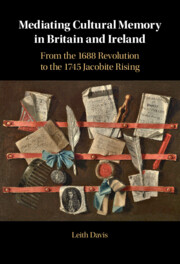 Mediating Cultural Memory in Britain and Ireland
Mediating Cultural Memory in Britain and Ireland Book contents
- Mediating Cultural Memory in Britain and Ireland
- Mediating Cultural Memory in Britain and Ireland
- Copyright page
- Contents
- Figures
- Acknowledgments
- Introduction
- Chapter 1 Of Documents and Declarations
- Chapter 2 Remembering to Forget
- Chapter 3 National Correspondences
- Chapter 4 Writing the 1715 Jacobite Rising
- Chapter 5 Reading the 1745 Jacobite Rising
- Conclusion
- Bibliography
- Index
Introduction
Published online by Cambridge University Press: 10 March 2022
- Mediating Cultural Memory in Britain and Ireland
- Mediating Cultural Memory in Britain and Ireland
- Copyright page
- Contents
- Figures
- Acknowledgments
- Introduction
- Chapter 1 Of Documents and Declarations
- Chapter 2 Remembering to Forget
- Chapter 3 National Correspondences
- Chapter 4 Writing the 1715 Jacobite Rising
- Chapter 5 Reading the 1745 Jacobite Rising
- Conclusion
- Bibliography
- Index
Summary
The Introduction situates the book within the theoretical parameters of Cultural Memory Studies, Print Culture Studies and British Studies. It provides a short history of Memory Studies, focusing on Pierre Nora’s concept of lieux de mémoire (sites of memory) as well as Aleida Assmann’s, Astrid Erll’s and Ann Rigney’s focus on media and memory. It surveys the complex media ecology of the late seventeenth and eighteenth centuries, arguing that the role that printed texts played in articulating sites of memory changed between 1688 and 1745 as the meaning of print itself changed in relation to oral and manuscript cultures. It compares the media environments of the beginning and end of this period by focusing on the creation and circulation of two documents – the Declaration of William of Orange (1688) and the Particulars of the Victory regarding the Battle of Culloden (1746). The Introduction concludes by suggesting that Michael Rothberg’s concept of noeuds de mémoire (knots of memory) provides a useful model for examining printed works of British national memory in the mid-eighteenth century.
Keywords
- Type
- Chapter
- Information
- Mediating Cultural Memory in Britain and IrelandFrom the 1688 Revolution to the 1745 Jacobite Rising, pp. 1 - 26Publisher: Cambridge University PressPrint publication year: 2022


